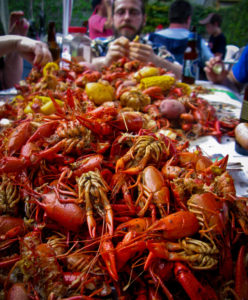Crawfish Boils
Crawfish boils are a springtime ritual in Louisiana.

Courtesy of Flickr.
A photograph of a picnic table covered with crawfish.
Crawfish boils are a springtime ritual in Louisiana. Large quantities of farm-raised or wild Louisiana crayfish (Procambarus clarkii), known locally as crawfish, are boiled in highly seasoned water contained in large stainless steel or aluminum cauldrons and cooked over high-pressure propane burners. These freshwater shellfish are then served informally, often over newspapers on long tables, alongside boiled corn on the cob and red potatoes. These often-sizable outdoor gatherings are a fairly recent cultural development. In the nineteenth and early twentieth centuries, eating crawfish carried a social stigma in Louisiana. Much like lobster in the United States and the Canadian Northeast, crawfish was considered to be food for the poor, until the 1959 Breaux Bridge Crawfish Festival helped rehabilitate local perceptions of the shellfish and its consumption. Today, boil houses and drive-thru boil spots specializing in crawfish are found in both urban and rural areas of the state, typically serving either three- or five-pound portions per person.
The Culture of Crawfish
From Native Americans such as the Choctaw band that identifies itself as Shatje-ohla (crawfish people), to the aqua farmers that produce tons of crawfish per season, Louisiana’s human inhabitants have enjoyed a long relationship with the crustacean Louisianans have nicknamed “mudbugs.” While visiting in 1770, one military officer noted: “The crawfish abound in this country; they are in every part of the earth, and when the inhabitants chuse [sic] a dish of them, they send to their gardens, where they have a small pond dug for that purpose, and are sure of getting as many as they have occasion for.” Despite their abundance, crawfish were not a central part of the local diet because of the social stigma surrounding their consumption.
Prior to the Civil War (1861–1865), the crustaceans generally were consumed in gumbo or crawfish bisque, a Creole soup featured in New Orleans restaurants and the homes of rural elite. Less affluent people ate them only during times of flood. After 1875, Catholics in southern Louisiana habitually ate crawfish during Lent, when religious restrictions prohibited the consumption of meat. Otherwise, “crawfishing” parties in rural southwestern Louisiana during the late 1870s usually served to collect bait for fishing expeditions. “Crawfishing may not be classed as a high-brow sport, but it certainly furnishes a lot of fun and satisfaction,” explained the Napoleonville Assumption Pioneer on March 18, 1933. For much of the early twentieth century, catching crawfish remained something akin to berry picking or fishing. Still, baited twine attached to a stick and nets produced small yields that were boiled as a light meal.
During the 1950s, the “culture of crawfish” became increasingly widespread. In 1958, Elvis Presley sang the praises of “Crawfish” in the Louisiana-based film King Creole. But the real catalyst came one year later, when Breaux Bridge in south central Louisiana launched a festival devoted to the crustacean. The Breaux Bridge Crawfish Festival, which has grown to draw more than 100,000 revelers, markets itself as “the world’s largest crawfish boil.”
The Anatomy of a Crawfish Boil
Boiling crawfish is largely a male-dominated culinary tradition. Live crawfish usually are purchased in forty-pound sacks from a fishmonger or aqua farmer. When the sack arrives at the cookout, cooks usually empty the sack into an ice chest and then fill the container with water and salt to “purge” the shellfish. This process cleans the exoskeleton of mud and debris and eliminates or reduces digested material in the intestine, which consumers may find unappealing. The crawfish are then placed into a perforated metal basket and dropped into a stockpot of boiling seasoned water.
Packaged seasoning blends, famously marketed by Zatarain’s as “crab boil,” are often used and generally include some combination of salt, black and red pepper, thyme, bay leaves, cloves, and marjoram. These ingredients and water are placed into a conventional stockpot, ranging from 20 to 160 quarts in size—custom and professional units are even larger. Corn, red potatoes, and halved lemons frequently accompany the crawfish in the pot, along with onions, garlic bulbs, mushrooms, sausage, or any other ingredient that strikes the cook’s fancy.
Boils are often all-day social affairs that build a sense of community among the participants. Diners usually separate the head (cephalothorax) from the tail (abdomen), the latter part of which contains the majority of a crawfish’s edible flesh. They then peel away the segmented abdominal somites. Some also suck the head, to enjoy the residual spices lodged in the fatty tissues and gonads of the crustacean’s cephalothorax.
Today the crawfish stands as a symbol of Cajun ethnicity. It appears on T-shirts, bumper stickers, posters, television commercials, and in other marketing campaigns. Arguably, Cajuns have replaced the Choctaw as Louisiana’s crawfish people.
